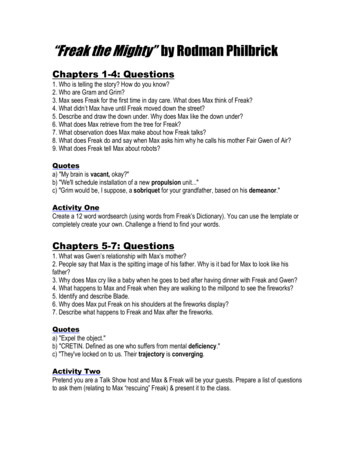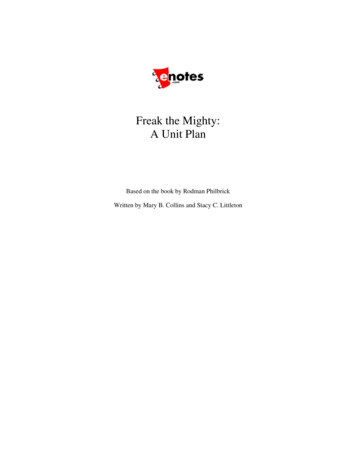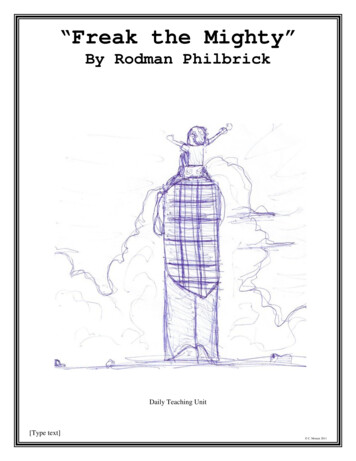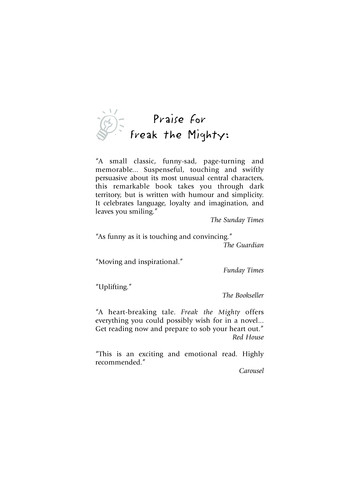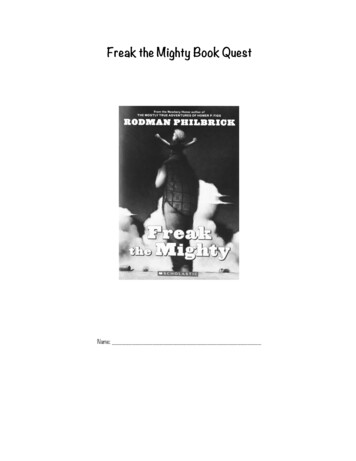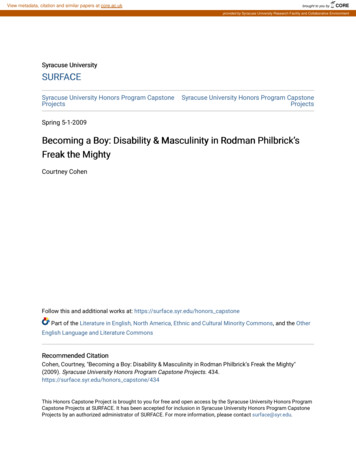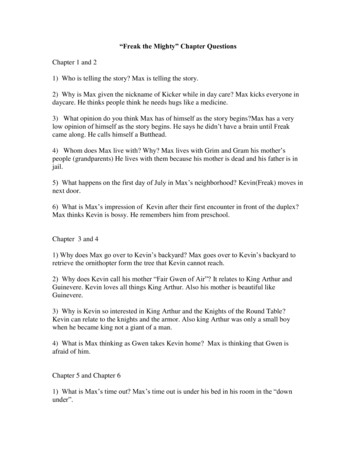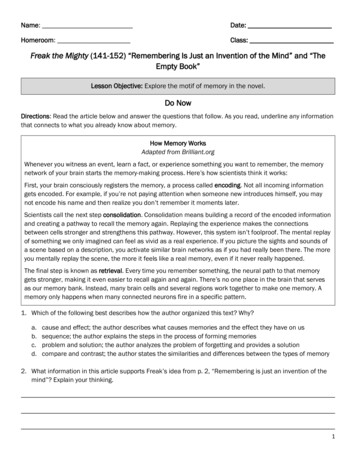
Transcription
Name:Date:Homeroom:Class:Freak the Mighty (141-152) “Remembering Is Just an Invention of the Mind” and “TheEmpty Book”Lesson Objective: Explore the motif of memory in the novel.Do NowDirections: Read the article below and answer the questions that follow. As you read, underline any informationthat connects to what you already know about memory.How Memory WorksAdapted from Brilliant.orgWhenever you witness an event, learn a fact, or experience something you want to remember, the memorynetwork of your brain starts the memory-making process. Here’s how scientists think it works:First, your brain consciously registers the memory, a process called encoding. Not all incoming informationgets encoded. For example, if you’re not paying attention when someone new introduces himself, you maynot encode his name and then realize you don’t remember it moments later.Scientists call the next step consolidation. Consolidation means building a record of the encoded informationand creating a pathway to recall the memory again. Replaying the experience makes the connectionsbetween cells stronger and strengthens this pathway. However, this system isn’t foolproof. The mental replayof something we only imagined can feel as vivid as a real experience. If you picture the sights and sounds ofa scene based on a description, you activate similar brain networks as if you had really been there. The moreyou mentally replay the scene, the more it feels like a real memory, even if it never really happened.The final step is known as retrieval. Every time you remember something, the neural path to that memorygets stronger, making it even easier to recall again and again. There’s no one place in the brain that servesas our memory bank. Instead, many brain cells and several regions work together to make one memory. Amemory only happens when many connected neurons fire in a specific pattern.1. Which of the following best describes how the author organized this text? Why?a.b.c.d.cause and effect; the author describes what causes memories and the effect they have on ussequence; the author explains the steps in the process of forming memoriesproblem and solution; the author analyzes the problem of forgetting and provides a solutioncompare and contrast; the author states the similarities and differences between the types of memory2. What information in this article supports Freak’s idea from p. 2, “Remembering is just an invention of themind”? Explain your thinking.1
Vocabulary: Prodigy, Obnoxious, nition1) an unusuallytalented childRelatedParts of Speech-Situations The piano prodigy was so small she couldhardly reach the piano keys, but she played aswell as the best adult pianists. 2) an amazingevent or actionvery unpleasant,annoying, oroffensiveImageobnoxiouslyadverb She couldn’t concentrate because of theobnoxious roar of the construction equipmentnext door. manifestationnoun The band changes musical styles constantly,but in their current manifestation, they focuson pop music. 1) a version orform ofsomething2) a sign thatshowssomethingclearlymanifestverb2
Vocabulary Active PracticeAs we apply our new word knowledge, be sure to use the vocabulary word in your answer!1. Do you think Freak is a prodigy? Why or why not?2. How might bitten nails be a manifestation of someone’s anxiety?3. What are some sounds you find obnoxious? How do these sounds affect you?4. How might Freak’s leg braces be a manifestation of his disability?5. When would a prodigy be likely to feel smug? Would you find this obnoxious?6. According to Freak, King Arthur in his first manifestation was a “wimpy little kid.” What did KingArthur become in his next manifestation? How was he transformed? Reading Reconsidered Curriculum3
Pages 141-1421. Turn and Talk: How much time has passed between the previous chapter and this one? How do you know?How Memory Works (cont’d)Adapted from Brilliant.orgThere are three main ways of forgetting memories. Sometimes, a memory simply fades over time. This mayhappen because the connections between brain cells gradually weaken or the triggers needed to retrieve itare lost. A second type of forgetting happens at night when we sleep. This is when we clear out unnecessaryinformation or erase outdated memories. The third type of forgetting is when a person intentionallysuppresses unpleasant memories. This is a way to regulate our emotions and to focus on the present insteadof getting lost in negative memories of the past. We don’t know exactly how it happens, but part of our brainseems to step in and block the troubling memories from being retrieved. Even though it’s still somewhere inour mind, eventually we can’t find it.Our brains have so many ways to forget because forgetting is one of the most important things we do.Forgetting allows us to move past traumatic life events. Forgetting also allows us to clear out “junk”; all of thesights sounds, smells, and pieces of information your brain processes every day would overflow our neuralpathways if we couldn’t sweep out the unnecessary information.2. Why might the author say forgetting is “one of the most important things we do”?3. On p. 141, Freak says, “The world is really and truly green all over.” What does he literally mean by this?What could the color green represent? Consider the passage of time and the importance of forgetting. Reading Reconsidered Curriculum4
4. Reread this excerpt from p. 142:“First you need to invent a time machine,” I say. “So you can go back there and give all the cavemen a hardtime about indoor plumbing.”Freak goes, “You don’t need a time machine if you know how to remember.”Which is something I’ll always remember, him saying that and me trying to figure it out.a. What might Freak mean when he says, “You don’t need a time machine if you know how to remember”?b. How does the science of memory support Freak’s statement? Include information from the article “HowMemory Works.”c. Challenge: In what verb tense is the final line of this excerpt written (e.g., past, present, future)? What tensedoes Max typically use in his narration? What might this change indicate? Reading Reconsidered Curriculum5
Pages 142-146: On Your OwnAnnotation Task: As you read, annotate any potential foreshadowing about Freak’s health. Is there anything theadults seem to know that Max does not?Notes5. On p. 143, Max narrates, “The deal is, this is really two birthdays for the price of one, because Freak theMighty is almost a year old.” What does he mean by this? Why might Freak say Freak the Mighty is aprodigy?6. What happens at the end of this chapter? How was this foreshadowed throughout pp. 142-146? (Hint: Youmay wish to review your annotations.)7. Challenge: Consider the reliability of Max’s narration in this section. Did he seem to be aware of the hintsthat something was seriously wrong with Freak? How might this be an example of dramatic irony? Reading Reconsidered Curriculum6
Pages 147-1528. Turn and Talk: Why might Max have brought the ornithopter to the hospital? Consider multiple reasons.9. On p. 149, Freak says, “I’m not coming home Not in my present manifestation.” How does Max interpretthis comment? What do you think as a reader?10. Reread this excerpt from pp. 150-151:“That’s for you,” he says. “I want you to fill it up with our adventures.”“Huh?”“Write it down, dummy. I was going to do it, but now it looks like I’ll be busy getting used to my new bionicbody. It’ll probably take me weeks just learning how to walk with long legs.”I put the book down.“You’re the one with the brain,” I say. “I’m the long legs.”“Don’t get me upset,” he warns. “I won’t have the time, so you’ll have to do it. Just write it all down like you’retalking. Put in all the fun we had, the cool things we did. Our adventures.”“But you know I can’t write, Kevin.”“It’s all in your head, Max, everything you can remember. Just tell the story of Freak the Mighty, no big deal.”a. A motif is an idea, symbol, image, or device that occurs multiple times throughout a text. What ideas orimages in this excerpt have repeated multiple times in the novel?Notes Reading Reconsidered Curriculum7
b. Kevin tells Max, “It’s all in your head everything you can remember. Just tell the story of Freak the Mighty,no big deal.” What might Kevin mean by this? Consider the motif of memory throughout the novel.11. Consider this conversation between Max and Grim on pp. 151-152:Nobody talks much at supper that night, except when Grim opens his big mouth and says, “Poor Gwen lookslike she’s in terrible pain.”I go, “Poor Gwen? She’s not the one having the special operation.”Grim and Gram just look at each other like they can’t believe I’m so dumb, and finally Gram says, “Maxwell,dear, make an effort to eat your vegetables.”a. Why might Grim call Kevin’s mom “Poor Gwen”? Challenge: When has he previously used this phrase?b. How might this moment be an example of dramatic irony? Consider the contrast between Max’s and Grim’sperspectives.12. What might the empty book represent or symbolize to Max? Reading Reconsidered Curriculum8
Name:Date:Homeroom:Class:Summative WritingDirections: Reread these excerpts from earlier in the novel.p. 2Looking sort of fierce is how I remember him. Exceptlater it was Freak himself who taught me thatremembering is a great invention of the mind, and if youtry hard enough you can remember anything, whether itreally happened or not.p. 14I’m pretty sure I remember looking back andseeing him sitting up in the wagon happy as canbe.But like Freak says later in this book, you canremember anything, whether it really happenedor not. All I’m really sure of is he never hit mewith that crutch.Explain how the motif of memory has been developed throughout the novel. Answer the following questionsand include evidence from pp. 141-152 in your response. This chapter is called “Remembering is Just an Invention of the Mind.” What is the scientific basis for thisstatement?How have Max’s memories been significant throughout the novel? Reading Reconsidered Curriculum9
Reading Reconsidered Curriculum10
Name:Date:Homeroom:Class:HomeworkDirections: Read the article below and answer the questions that follow.A "bionic" leg that's a marvel of 21st century engineeringby Los Angeles Times, adapted by Newsela staffA lot goes into walking. It takes balance, strength andbrainpower. Just ask Zac Vawter. He lost his leg in amotorcycle accident in 2009. But with the help of ateam of scientists and doctors, he has taught awhole new type of artificial leg to walk, kick, and doeverything else that a leg does.The team includes scientists who develop software,surgeons, and people who make artificial limbscalled prosthetics. Together they designed a leg thatcan receive commands directly from Vawter’s brain.The leg has learned to read what Vawter wants it to do. A bundle of nerves that end above his missing kneegives signals to the leg, a scientific report said.Roughly 1 million Americans have lost all or part of a leg. Vawter and his robotic leg offer hope that futureprosthetics might feel more natural.Imagine It, and It HappensVawter’s prosthetic is a marvel of 21st century engineering. But Vawter’s ability to control the prosthetic withhis thoughts makes his case remarkable. If he wants his artificial toes to curl toward him, all he has to do isimagine the movements. The same with shifting his artificial ankle so he can walk down a ramp.The leg weighs just over 10 pounds. It has two separate engines. One powers movement in the ankle and theother in the knee. It has sensors that are capable of detecting and measuring movement all over.In most prosthetics, the wearer has to turn a key to change from one type of movement to another. Not so inVawter's robotic leg."Teaching" the Leg to Read“With this leg, it just flows,” said the 32-year-old software engineer. “There isn’t anything special I have to doto make it work right.” Vawter lives in Washington. Most of the time he uses a typical prosthetic. But hetravels to Chicago several times a year to work with the robotic leg.Vawter couldn't just strap on the bionic lower limb. First engineers in Chicago had to “teach” the leg how toread tiny muscle movements in his right thigh. Those movements told the leg what Vawter wanted it to do. Reading Reconsidered Curriculum11
Vawter spent hours with his thigh wired up. He imagined making certain movements with his missing knee,ankle and foot.Engineers broke down those recorded electrical signals to log an entire collection of movements. They usedspecial software to do this. The prosthetic could then be programmed to recognize the smallest twitch of amuscle in Vawter’s thigh.It took a new type of surgery to make this possible, though. In most amputations, the nerves in the thigh areleft to wither or die.Rewiring the Severed NervesDr. Todd Kuiken is a neurosurgeon at the rehabilitation institute. He developed the new method. It is called“reinervation.” Vawter’s orthopedic surgeon was trained in the delicate operation. He rewired the severednerves to control some of the muscles in Vawter’s thigh. The muscles would be used less frequently after theamputation.Those nerves recovered from the shock of the injury. Then they began to regrow. They could carry electricalsignals. When Vawter thought about flexing his right foot in a particular way, the nerve endings would causea special motion in his hamstring. The same sort of thing happened with other muscle movements.The bionic leg performs better than standard prosthetics, according to the report. The robotic leg,programmed to follow Vawter’s commands, reduced errors by 44 percent. Those errors cause unnaturalmovements, pain and falls.Vawter said he had “fallen down a whole bunch of times” while wearing his everyday prosthetic. He has notfallen once while moving around on his bionic leg.He said he could move a lot faster too — which would be helpful for keeping up with his 5-year-old son and 3year-old daughter. But first, Vawter added, he needs to persuade Hargrove’s team to let him wear it home.1. How is a bionic leg different from a traditional prosthetic?2. What is the main idea of the section “Rewiring the Severed Nerves”? Reading Reconsidered Curriculum12
Just tell the story of Freak the Mighty, no big deal.” a. A motif is an idea, symbol, image, or device that occurs multiple times throughout a text. What ideas or images in this excerpt have repeated multiple tim

